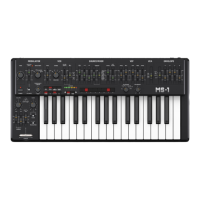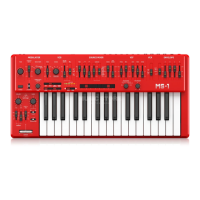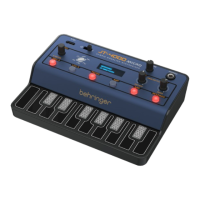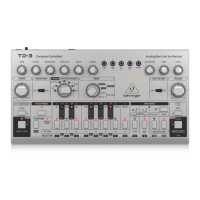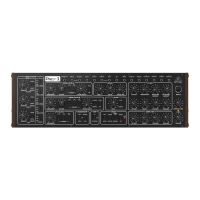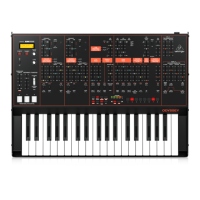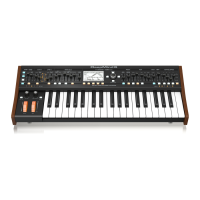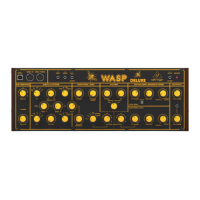SUSTAIN – adjust the amplitude to a level which is sustained after the attack time and initial decay time have
been reached. RELEASE – adjust the time taken for the amplitude level to decrease after the note is released.
22. POWER – turn the synthesizer on or off. Make sure all the connections are made before turning on the unit.
The LED shows when power is applied and the synthesizer is turned on.
23. AUTO DAMP ON/OFF – when OFF, and a chord is played in POLY mode, the chord will continue to play until
all notes are released, or a new note is played. When ON, only non-released notes will continue to play; the
others are damped.
24. TRIGGER – there are two options for how the attack cycle of both envelope generators are triggered by the
keyboard. (This also affects the rear panel TRIG OUT.)
SINGLE – a new note will trigger the attack cycle, but not if previous notes are being held, or HOLD is on.
MULTIPLE – a new note will trigger the attack cycle, even if previous notes are being held, or HOLD is on.
25. NOISE – adjust the level of the internal Noise source.
Rear Panel
26. DC INPUT – connect the supplied 12V DC power adapter here. The power adapter can be plugged into an AC
outlet capable of supplying from 100V to 240V at 50 Hz/60 Hz. Use only the power adapter supplied.
27. USB PORT – This USB type B jack allows connection to a computer. The MONOPOLY will show up as a class-
compliant USB MIDI device, capable of supporting MIDI in and out.
USB MIDI IN – accepts incoming MIDI data from an application.
USB MIDI OUT – sends MIDI data to an application.
28. MIDI IN – this 5-pin DIN jack receives MIDI data from an external source. This will commonly be an external
MIDI keyboard, hardware sequencer, or a computer equipped with a MIDI interface.
MIDI OUT – this 5-pin DIN jack outputs MIDI data.
MIDI THRU – this 5-pin DIN jack is used to pass through MIDI data received at the MIDI INPUT.
29. ARPEGGIO – use this 1/4″ TRS clock input to trigger the Arpeggio using an external device.
30. PORTAMENTO – use this to engage or disengage the portamento using a footswitch.
31. VCF – the filter’s cutoff frequency can be modulated using a pedal, such as the Behringer FCV100 V2 or FC600
V2 expression pedal (with the CV polarity set to TRS, and using a TRS cord).
32. VCO – the pitch can also be controlled using an pedal, such as those mentioned above.
33. TRIG POLARITY – selects the triggering polarity of TRIG In and Out, from either +15V (positive-going, Voltage
triggering) or ground (negative-going, Switch triggering).
34. TRIG – connect to the trigger inputs and outputs of another MONOPOLY unit, compatible monophonic
synthesizers, or other modular equipment. Set the TRIG POLARITY switch to match the trigger inputs and
outputs of your external equipment.
TRIG OUT – connect this output to the trigger input of your external equipment. The output type is set by the
TRIG POLARITY switch and follows the SINGLE/MULTIPLE TRIGGER front panel switch.
TRIG IN – connect this input to the trigger output of your external equipment. A trigger signal will turn all VCOs
on and trigger the VCF and VCA Envelope Generators.
35. CV – connect to the CV inputs and outputs of another MONOPOLY unit, compatible monophonic synthesizer, or
other modular equipment. These should use the (1V/octave) control voltage system.
36. CV IN – connect this input to the CV output of your external equipment. Only the external voltages applied to
this input will control the note. The VCOs will be in mono unison mode. CV OUT – connect this output to the CV
input of your external equipment. The output is of the highest note, last played. The front panel TRANSPOSE
switch will affect the CV OUT value by 1 volt changes per octave.
37. PHONES – connect your headphones to this 1/4″ TRS output. Make sure the headphone volume is turned
down before putting on headphones.
OUTPUT – connect this 1/4″ TS output to the line-level input of your external equipment.
MONOPOLY Getting started
OVERVIEW
This ‘getting started’ guide will help you set up the MONOPOLY analog synthesizer and briefly introduce its
capabilities.
CONNECTION
To connect the MONOPOLY to your system, please consult the connection guide earlier in this document.
SOFTWARE SETUP
The MONOPOLY is a USB Class Compliant MIDI device, and so no driver installation is required. The MONOPOLY
does not require any additional drivers to work with Windows and MacOS.
The “Synthtool” application allows you to select the MIDI channel number and to set and adjust various parameters of
the MONOPOLY to suit your preferences. SysEx commands can also be used. Please see the information later in

